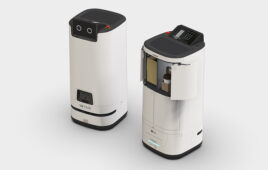|
Listen to this article
|
Researchers at the University of Southern California (USC) have developed a design for a sensor inspired by the folding patterns of origami that uses 3D electrodes to track deformation in robots.
The project was led by Hangbo Zhao, who holds dual appointments as an assistant professor in the Department of Aerospace and Mechanical Engineering and the Alfred E. Mann Department of Biomedical Engineering. Zhao wanted to find a new way to measure stretchability.
Typically, stretchability and recovery, which are crucial metrics for predicting and controlling the motion of a robot, are measured using cameras. This process, however, doesn’t work well outside of a lab, as when robots are out in the world, operating in space, or within the human body, they can’t be surrounded by multiple cameras.
Additionally, soft robots that stretch and deform are typically made of a soft material like rubber. While these materials are good at stretching, they can also undergo irreversible changes in the material properties through repeated use.
Instead of using cameras and soft materials, Zhao and his team leveraged their previous work in the designs and manufacturing of small-scale 3D sculptures that apply principles of origami. These methods allowed them to create a sensor that can measure a strain range up to three times higher than a typical sensor.
To do this, the USC team built a 3D structure of electrodes that converts stretch and release to a process of folding and unfolding. This process allows the shape of the robot to change without transforming the substance of the material itself.
As these electrodes unfold, they capture the strength of the electrical field. The team then developed a model that converts this electrical field reading into a measurement of deformation. This method allows the sensors to be used repeatedly and to give precise readings even when measuring large and dynamic deformations of soft bodies.
This approach is best suited for responding to large deformations that existing sensors aren’t capable of identifying accurately. This is because, through folding, engineers can achieve large jumps in dimensions without causing a change in material.
“We integrate the 3D origami-inspired electrodes with a soft, stretchable substrate through covalent bonding,” Zhao said. “This unique combination allows us to measure a very large deformation, as much as 200 percent strain, with an ultra-low hysteresis of around 1.2 percent. There’s also a very fast response, within 22 milliseconds.”
These sensors can be attached to soft bodies in motion, which includes anything from mechanical tendons found in prosthetic legs to human internal organs.
The high-performing design of these sensors means they are capable of rapidly measuring high deformation with maximum precision. The sensors also have a sensing area of just a few square millimeters, which allowed the team to measure deformation locally. The sensors can also detect strain from different directions.
While these sensors were designed for controlling soft robotics, they can also be suited for innovations in biomedicine.
“We can apply these sensors as wearable or implantable biomedical devices for healthcare monitoring,” Zhao said. “For example, tracking the movement and flexibility of our skin or our joints. There’s also high demand for developing implantable sensors that can continuously monitor the functional status of internal organs that undergo cyclic expansion and contraction.”
The USC team’s paper, “High-Stretchability and Low-Hysteresis Strain Sensors Using Origami-Inspired 3D Mesostructures,” was published in the journal Science Advances.






Tell Us What You Think!